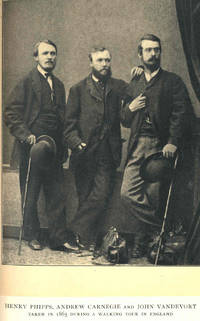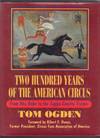
The inside history of the Carnegie Steel Company; a romance of millions
by Bridge, James Howard, 1858-1939
- Used
- fair
- Condition
- Fair
- Seller
-
Stockbridge, Georgia, United States
Payment Methods Accepted
About This Item
New York, The Aldine Book Company, 1903, 1903. Fair. xv, 369 p. illus., 3 pl., 9 port. (incl. front.) 24 cm. ; LCCN: 03-29880 ; LC: HD9519.C3; Dewey: 338 ; OCLC: 237049 ; ex-lib, stamps, labels, date due, pocket, reinforced binding ; front hinge starting ; foxing ; marbled endpapers ; numerous photographs, illustrations, plates ; facsimiles ; The Humble Beginning 1853-1863 : The little Kloman forge in Girty's Run—Excellent work- manship of the Kloman brothers—Thomas N. Miller and Henry Phipps join them—Notable extension of business—Prosperity brought by the war—A new mill is built at Twenty-ninth Street —Renewed prosperity—Anthony Kloman sells out—Quarrel among the partners -- "A Most Hazardous Enterprise" 1863-65: Andrew Carnegie enters as peacemaker—Some particulars of his life—His efforts produce fresh discord—Makes agreement under which Miller is forced out—Thomas M. Carnegie gets an interest—Miller and Andrew Carnegie start a rival mill at Thirty third Street—Its failure—Consolidation of the two mills into Union Iron Mills Company—Andrew Carnegie's disappointment —Reproaches Miller for getting him into the iron business—Calls it a "most hazardous enterprise" -- Early Struggles And Successes -- 1865: Phipps and Carnegie go on foreign tour and leave the business —Its narrow escape from disaster—T. M. Carnegie saves it—William Coleman's helpful advice—Phipps' trials on his return—UnforTunate-ontside venture—Andrew Carnegie's quarrel with Miller —His depreciation of the enterprise—Purchases Miller's stock— The first labor strike—Importations of foreign workmen—Ingenuity of a German—He shows Klomau how to build a " Universal Mill"—Andrew Carnegie's resistance to innovations—" Pioneering don't pay"—Opposes the great slabbing-mill—Its excellent work —Kloman's inventive genius—Economies of Mr. Phipps—Brings in John Walker, his brother-in-law—Forms company to buy Twenty-ninth Street mill—Wilson, Walker & Co.—Advantages of the change -- Iron Railway Bridges -- 1865: Formation of the Keystone Bridge Company—Incorporates previous business of Piper & Shiffler—Andrew Carnegie's claims as a pioneer—His strange mistakes—Character of Piper—Iron used in bridges a hundred years before Carnegie—Early iron railroad bridges—Commercial morals and early railroad management— Officials and outside interests—Influential backing of the Keystone Bridge Company—Its early prosperity—A balance sheet— Recent losses -- A Rivalry Of Great Furnaces 1872 : Schemes for iron-smelting—Phipps and associates invited to join them—Coleman advises construction of independent furnace— Lucy furnace built—Enters upon long rivalry with the Isabella— Interesting struggle for supremacy—Remarkable achievements— Description of old-time methods—Great services of H. M. Curry —Inventor Whitwell's improvements—Valuable discovery by Mr. Phipps—Hisclose trading—Disagreements of partners—Kloman's unfortunate venture—The panic of 1873—On the brink of bankruptcy—Kloman leaves the firm—Record of the furnaces -- Beginnings And Growth Ok The Steel Business 1875 : Erroneous histories published of this event-—Vanity of supposed founders—Filching of laurel wreaths from dead men's graves— Coleman the real founder—Secures option, with T. M. Carnegie, of the Braddock site—Gets his friends interested—The elder Carnegie's opposition—Sees progress of Bessemer steel in England— Returns enthusiastic and joins the enterprise—Helpfulness of Colonel Scott and Mr. J. Edgar Thomson—Curious result of strike at Johnstown—Captain Jones made superintendent—His remarkable ability—letter exemplifying his broad views—Causes of success—Discrimination in freight rates—Shinn's methods of accounting—Disagreements of partners—They lead to construction of blast-furnaces—Wonderful records made in smelting—Also in converting works and rail-mill—Consternation in England -- Some Inside Financial History -- 1875-1888 : Secrecy hitherto maintained concerning profits— etc, etc ; FAIR
Reviews
(Log in or Create an Account first!)
Details
- Seller
- Joseph Valles - Books
(US)
- Seller's Inventory #
- 005610
- Title
- The inside history of the Carnegie Steel Company; a romance of millions
- Author
- Bridge, James Howard, 1858-1939
- Book Condition
- Used - Fair
- Quantity Available
- 1
- Publisher
- New York, The Aldine Book Company, 1903
- Date Published
- 1903
- Keywords
- agreed agreement Amalgamated Association Andrew Carnegie Andrew Kloman Bessemer process Bessemer steel blast-furnace Board of Managers bonds Braddock brought built capital Captain Jones Carnegie Company Carnegie Steel Company Carnegie's cent chairman Clem
- Bookseller catalogs
- Catalog 60 - General;
Terms of Sale
Joseph Valles - Books
All items subject to prior sale.
Returns accepted in same condition within 10 business days for any reason.
PAYMENT: Cash with order. International orders require payment in U.S. funds drawn on a U.S. Bank or through an International Money Order. Libraries and institutions may defer billing upon our receipt of purchase order.
Books graded conservatively with prominent defects mentioned.
About the Seller
Joseph Valles - Books
Biblio member since 2005
Stockbridge, Georgia
About Joseph Valles - Books
Science
(Some listings may display information using Chinese, Japanese, Korean or Russian fonts)
(Some listings may display information using Chinese, Japanese, Korean or Russian fonts)
Glossary
Some terminology that may be used in this description includes:
- Leaves
- Very generally, "leaves" refers to the pages of a book, as in the common phrase, "loose-leaf pages." A leaf is a single sheet...
- Fair
- is a worn book that has complete text pages (including those with maps or plates) but may lack endpapers, half-title, etc....
- Hinge
- The portion of the book closest to the spine that allows the book to be opened and closed.

